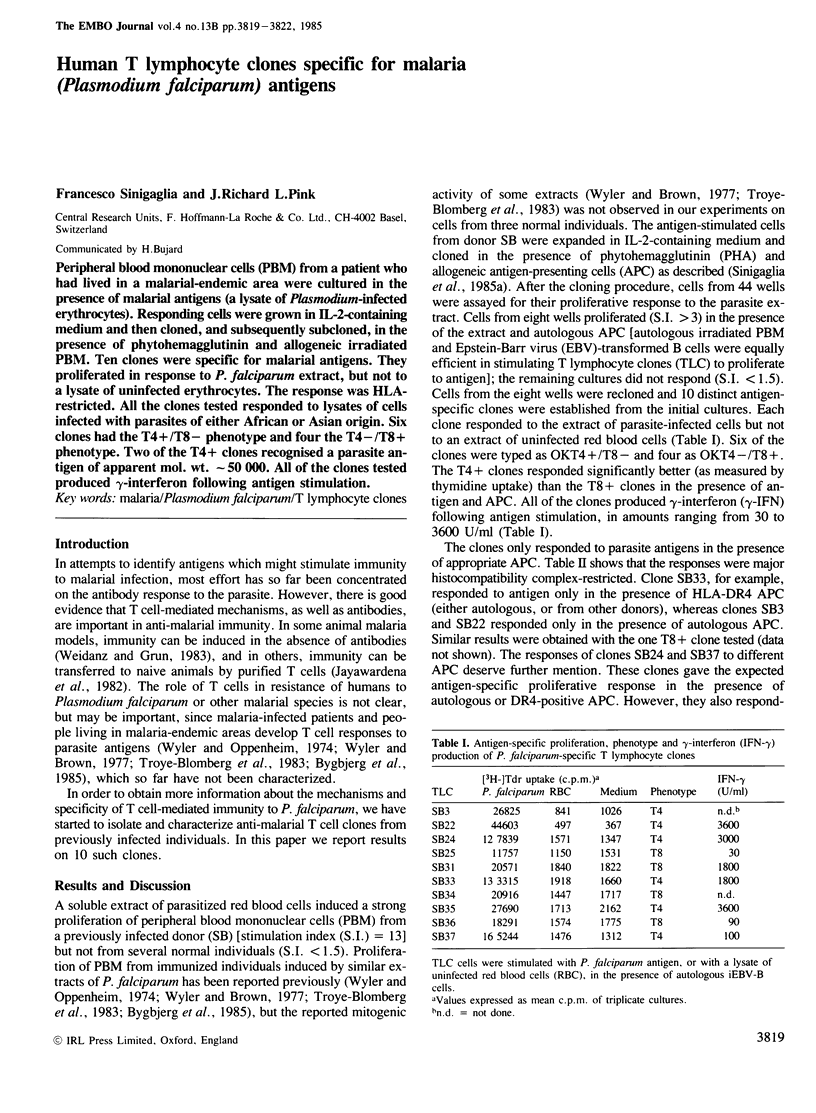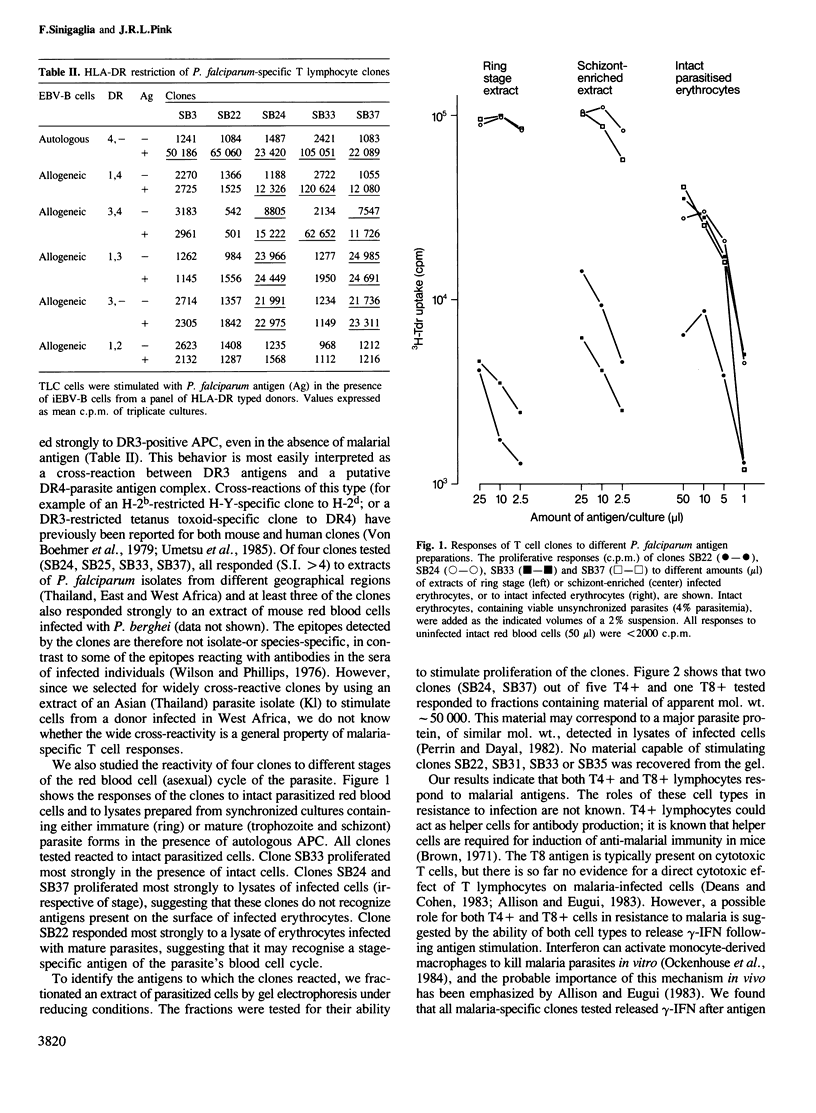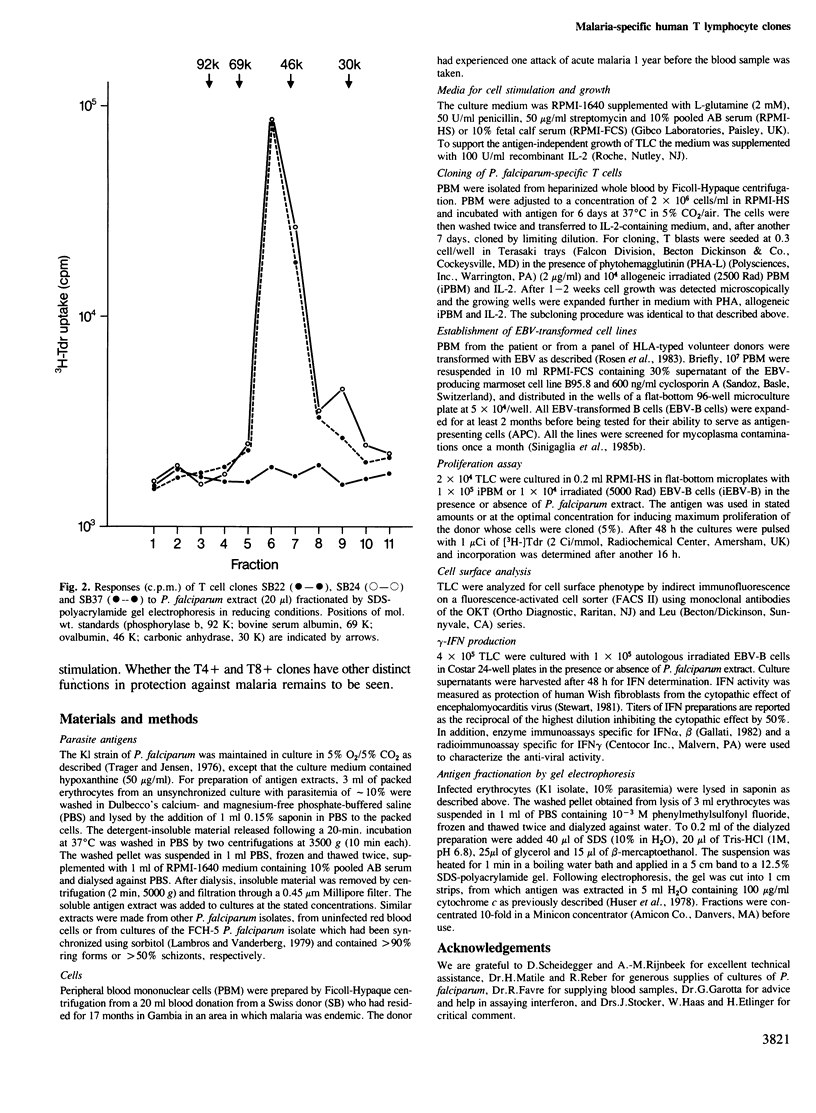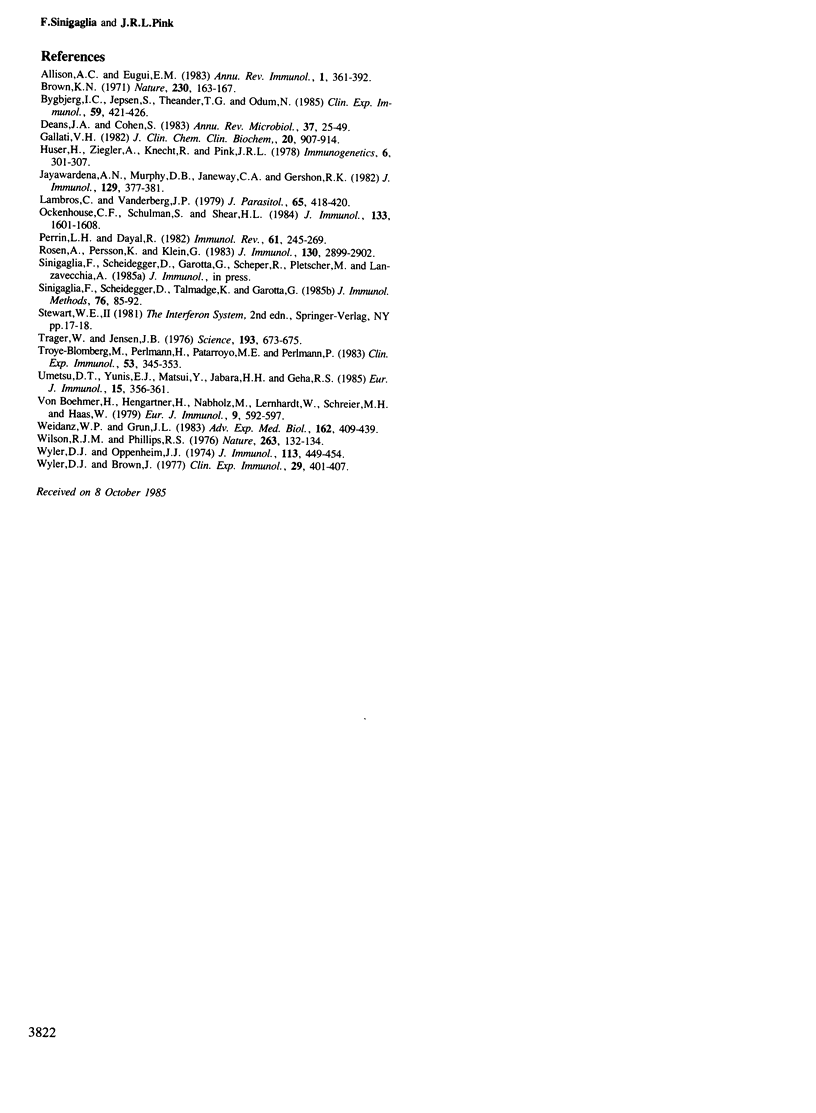Abstract
Peripheral blood mononuclear cells (PBM) from a patient who had lived in a malarial-endemic area were cultured in the presence of malarial antigens (a lysate of Plasmodium-infected erythrocytes). Responding cells were grown in IL-2-containing medium and then cloned, and subsequently subcloned, in the presence of phytohemagglutinin and allogeneic irradiated PBM. Ten clones were specific for malarial antigens. They proliferated in response to P. falciparum extract, but not to a lysate of uninfected erythrocytes. The response was HLA-restricted. All the clones tested responded to lysates of cells infected with parasites of either African or Asian origin. Six clones had the T4+/T8- phenotype and four the T4-/T8+ phenotype. Two of the T4+ clones recognised a parasite antigen of apparent mol. wt. approximately 50 000. All of the clones tested produced gamma-interferon following antigen stimulation.
Full text
PDF



Selected References
These references are in PubMed. This may not be the complete list of references from this article.
- Allison A. C., Eugui E. M. The role of cell-mediated immune responses in resistance to malaria, with special reference to oxidant stress. Annu Rev Immunol. 1983;1:361–392. doi: 10.1146/annurev.iy.01.040183.002045. [DOI] [PubMed] [Google Scholar]
- Bygbjerg I. C., Jepsen S., Theander T. G., Odum N. Specific proliferative response of human lymphocytes to purified soluble antigens from Plasmodium falciparum in vitro cultures and to antigens from malaria patients' sera. Clin Exp Immunol. 1985 Feb;59(2):421–426. [PMC free article] [PubMed] [Google Scholar]
- Deans J. A., Cohen S. Immunology of malaria. Annu Rev Microbiol. 1983;37:25–49. doi: 10.1146/annurev.mi.37.100183.000325. [DOI] [PubMed] [Google Scholar]
- Gallati H. Interferon: Wesentlich vereinfachte, enzym-immunologische Bestimmung mit zwei monoklonalen Antikörpern. J Clin Chem Clin Biochem. 1982 Dec;20(12):907–914. [PubMed] [Google Scholar]
- Jayawardena A. N., Murphy D. B., Janeway C. A., Gershon R. K. T cell-mediated immunity in malaria. I. The Ly phenotype of T cells mediating resistance to Plasmodium yoelii. J Immunol. 1982 Jul;129(1):377–381. [PubMed] [Google Scholar]
- Lambros C., Vanderberg J. P. Synchronization of Plasmodium falciparum erythrocytic stages in culture. J Parasitol. 1979 Jun;65(3):418–420. [PubMed] [Google Scholar]
- Ockenhouse C. F., Schulman S., Shear H. L. Induction of crisis forms in the human malaria parasite Plasmodium falciparum by gamma-interferon-activated, monocyte-derived macrophages. J Immunol. 1984 Sep;133(3):1601–1608. [PubMed] [Google Scholar]
- Perrin L. H., Dayal R. Immunity to asexual erythrocytic stages of Plasmodium falciparum: role of defined antigens in the humoral response. Immunol Rev. 1982;61:245–269. doi: 10.1111/j.1600-065x.1982.tb00379.x. [DOI] [PubMed] [Google Scholar]
- Rosén A., Persson K., Klein G. Human monoclonal antibodies to a genus-specific chlamydial antigen, produced by EBV-transformed B cells. J Immunol. 1983 Jun;130(6):2899–2902. [PubMed] [Google Scholar]
- Sinigaglia F., Scheidegger D., Talmadge K., Garotta G. A sensitive and quantitative microassay for the detection of mycoplasma contamination: inhibition of IL-2 dependent cell line proliferation. J Immunol Methods. 1985 Jan 21;76(1):85–92. doi: 10.1016/0022-1759(85)90483-1. [DOI] [PubMed] [Google Scholar]
- Trager W., Jensen J. B. Human malaria parasites in continuous culture. Science. 1976 Aug 20;193(4254):673–675. doi: 10.1126/science.781840. [DOI] [PubMed] [Google Scholar]
- Troye-Blomberg M., Perlmann H., Patarroyo M. E., Perlmann P. Regulation of the immune response in Plasmodium falciparum malaria. II. Antigen specific proliferative responses in vitro. Clin Exp Immunol. 1983 Aug;53(2):345–353. [PMC free article] [PubMed] [Google Scholar]
- Umetsu D. T., Yunis E. J., Matsui Y., Jabara H. H., Geha R. S. HLA-DR-4-associated alloreactivity of an HLA-DR-3-restricted human tetanus toxoid-specific T cell clone: inhibition of both reactivities by an alloantiserum. Eur J Immunol. 1985 Apr;15(4):356–361. doi: 10.1002/eji.1830150410. [DOI] [PubMed] [Google Scholar]
- Weidanz W. P., Grun J. L. Antibody-independent mechanisms in the development of acquired immunity to malaria. Adv Exp Med Biol. 1983;162:409–423. doi: 10.1007/978-1-4684-4481-0_37. [DOI] [PubMed] [Google Scholar]
- Wilson R. J., Phillips R. S. Method to test inhibitory antibodies in human sera to wild populations of Plasmodium falciparum. Nature. 1976 Sep 9;263(5573):132–134. doi: 10.1038/263132a0. [DOI] [PubMed] [Google Scholar]
- Wyler D. J., Brown J. Malaria antigen-specific T-cell responsiveness during infection with Plasmodium falciparum. Clin Exp Immunol. 1977 Sep;29(3):401–407. [PMC free article] [PubMed] [Google Scholar]
- Wyler D. J., Oppenheim J. J. Lymphocyte transformation in human Plasmodium falciparum malaria. J Immunol. 1974 Aug;113(2):449–454. [PubMed] [Google Scholar]
- von Boehmer H., Hengartner H., Nabholz M., Lernhardt W., Schreier M. H., Haas W. Fine specificity of a continuously growing killer cell clone specific for H-Y antigen. Eur J Immunol. 1979 Aug;9(8):592–597. doi: 10.1002/eji.1830090804. [DOI] [PubMed] [Google Scholar]


